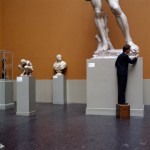The Private Museum Boom
 Art critics have unfairly attacked the recent trend of billionaires financing and creating their own museums.
Art critics have unfairly attacked the recent trend of billionaires financing and creating their own museums.
Christopher Knight, art critic for the Los Angeles Times, made an interesting comment in a recent piece about construction plans for an institution to house the collection of Eli and Edythe Broad in Los Angeles. He stated:
The fuel for private museums is almost always skyrocketing wealth mixed with favorable tax policy. That's why few private art museums were established during the huge expansion in the American economy that occurred between 1950 and 1970. Then, the gross domestic product was growing around 3.4% annually, but the top marginal income tax rate paid by the wealthiest Americans ranged between 91% and 70%. By 2009, growth in the GDP had slowed to one-quarter of 1% while the top tax rate had plummeted to 35%. Regardless of philanthropic motive, the Broad Collection — like the Huntington, the Frick and most of the other great private art institutions before it — is also Gilded Age residue.
Knight's piece was written in part as a response to an article by Clare O'Connor in Forbes that highlighted the recent trend of billionaires financing and creating their own museums. Such museums have been criticized by some as "ego-seums" and both of O'Connor's and Knight's pieces address that critique. Knight's response is more direct, and attempts to place such museums in a broader economic and political context. He points out that many beloved cultural institutions in the United States started out as the pet projects of extremely wealthy individuals, and that the foundation of the Broad Collection would not be a new development because of the nature of its inception.
Knight states that the eras in which many private museums are created are also eras in which the economy is booming and taxes on the wealthy are kept generally low. He also points out that one shouldn't assume that a private museum would lack engagement with the general public, and he mentions Houston's magnificent Menil Collection as a model for what the Broad Collection could be.
With regard to the economic and public policy part of his argument, Knight is raising an important point. The benefits and shortcomings of the economic systems generally linked to the Gilded Age and the economic era that started with the Reagan Administration and continued until the recent economic unpleasantness should and will be debated fiercely. It appears, however, that whatever one thinks of the economic structure of such eras, one benefit of them is the creation of unique museums that have a strong niche in the cultural life of this country. These sorts of museums arise from the wealth created in such eras and the vision of wealthy founders, and by their very nature differ from the classic large metropolitan museums and small alternative arts spaces that one finds in most major urban centers. The creation of such museums may be an unintended consequence of what Knight refers to as "skyrocketing wealth mixed with favorable tax policy", but it is an end result worth noting.